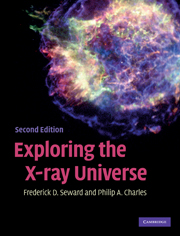Book contents
- Frontmatter
- Contents
- List of acronyms
- Foreword
- Chapter 1 Birth and childhood of X-ray astronomy
- Chapter 2 X-ray emission and interaction with matter
- Chapter 3 Tools and techniques
- Chapter 4 Solar system X-rays
- Chapter 5 X-ray absorption and scattering in the Interstellar Medium
- Chapter 6 Active stellar coronae
- Chapter 7 Early-type stars
- Chapter 8 Supernova explosions and their remnants
- Chapter 9 Neutron stars, pulsars, pulsar wind nebulae, and more supernova remnants
- Chapter 10 Cataclysmic variable stars
- Chapter 11 X-ray binaries
- Chapter 12 Black-hole X-ray binaries
- Chapter 13 Normal and starburst galaxies
- Chapter 14 Active galactic nuclei
- Chapter 15 Clusters of galaxies
- Chapter 16 The diffuse X-ray background
- Chapter 17 Gamma-ray bursts
- Index
- Plate section
Chapter 16 - The diffuse X-ray background
Published online by Cambridge University Press: 05 June 2012
- Frontmatter
- Contents
- List of acronyms
- Foreword
- Chapter 1 Birth and childhood of X-ray astronomy
- Chapter 2 X-ray emission and interaction with matter
- Chapter 3 Tools and techniques
- Chapter 4 Solar system X-rays
- Chapter 5 X-ray absorption and scattering in the Interstellar Medium
- Chapter 6 Active stellar coronae
- Chapter 7 Early-type stars
- Chapter 8 Supernova explosions and their remnants
- Chapter 9 Neutron stars, pulsars, pulsar wind nebulae, and more supernova remnants
- Chapter 10 Cataclysmic variable stars
- Chapter 11 X-ray binaries
- Chapter 12 Black-hole X-ray binaries
- Chapter 13 Normal and starburst galaxies
- Chapter 14 Active galactic nuclei
- Chapter 15 Clusters of galaxies
- Chapter 16 The diffuse X-ray background
- Chapter 17 Gamma-ray bursts
- Index
- Plate section
Summary
Early observations, 1965
The X-ray background was not anticipated. It was discovered in 1962 during the rocket flight which first detected Sco X-1, the first successful attempt to detect X-rays from sources other than the Sun or Earth. An uncollimated detector viewing about 10 000 square degrees of the sky was used. Giacconi et al. (1962) concluded that the background was of ‘diffuse character’ and due to X-rays of about the same energy as those from Sco X-1. The observed diffuse signal in this detector could have been generated by a few moderately strong point sources spread over the sky. The next observations, however, with detectors collimated to observe only 100 square degrees, showed the background to be indeed diffuse and of uniform brightness to at least 10 per cent.
There was no doubt that this background existed. The signals observed were strong and unmistakable. When detectors in rocket payloads were uncovered, pointed at any part of the night sky, the count rate always increased. All early observations, without exception, showed a few bright sources embedded in a uniform X-ray glow. The night sky at X-ray wavelengths was uniformly bright! Sources appeared superposed on this background, rather like stars viewed with the naked eye on a night with a full moon; when the faint stars disappear into the background of moonlight scattered from the atmosphere. Because no structure was observed and the emission was apparently uniform, this phenomenon has been called the ‘diffuse X-ray background’.
- Type
- Chapter
- Information
- Exploring the X-ray Universe , pp. 325 - 339Publisher: Cambridge University PressPrint publication year: 2010



